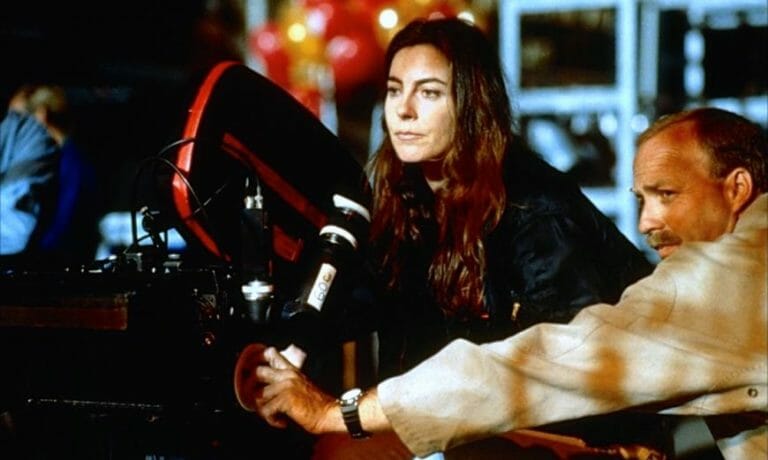Sign up for the
TSL Newsletter
and get $50 off Final Draft 12
By Tessa Chudy · March 26, 2015

Kathryn Bigelow's first movie was released in 1981, thirty-four years later she is arguably the best known female director in Hollywood. Her reputation is due not only to the fact that she remains the only female director to win an Academy Award, but also to her impressive body of work which has focused mainly on the traditionally male oriented genre of Action/Thrillers.
Bigelow began her creative career as a painter before studying film at Columbia University where she completed her master's degree in the 70s. Her films have almost exclusively dealt with themes of violence and power. Interestingly, Bigelow is not the typical celebrity her status might suggest; personal details about her are scarce and refreshingly she lets her films speak for her. Bigelow is not a female director in the sense of a Nora Ephron or a Jane Campion. Perhaps her most obvious reference point is Ida Lupino (1918-1995), an actress turned director whose films of the early 50s were virtually indistinguishable in style and tone from the work of male directors. Bigelow should instead be considered as a director (as opposed to a female director), as her films demand to be taken on their own merits.
The short film The Set-Up (1978) provides an interesting precursor to Bigelow's subsequent directing career. It features images of two men fighting while two philosophers deconstruct their actions. This was followed three years later by Bigelow's debut which was co-written and co-directed with Monty Montgomery. The Loveless (1981) is a highly stylized retro 50s set biker film. The Loveless is a slow-paced drama about bikers passing through a dead end town, reminiscent of The Wild One (1953), it explodes into a violent ending, but is emotionally detached and unsatisfying.
Near Dark (1987) was a giant leap forward from The Loveless, gritty, stylish and bleakly violent, it has emerged as a minor classic in the tired vampire movie field. The action follows a family of vampires as they travel the highways in search of fresh blood. Near Dark was followed by Blue Steel (1989) (both of which Bigelow co-wrote the screenplays for) one of only a few of Bigelow's films that feature a female protagonist. Jamie Lee Curtis stars as a rookie cop who becomes the object of obsession for a violent psychopath. Blue Steel is an exciting Thriller that has aged gracefully and remains an intense example of the genre, tightly structured and well paced.
Bigelow's major breakthrough however, came in 1991 with Point Break, which on paper sounds absolutely ridiculous – a group of surf junkie bank robbers who commit their robberies wearing rubber masks of dead American presidents are infiltrated by an FBI agent, who falls under their spell. Far-fetched as it may be, Point Break is an exhilarating experience. Bigelow keeps the action and tension high throughout.
Strange Days (1995) was a commercial failure, but may be Bigelow's masterpiece. It is an ambitious futuristic Science Fiction Thriller with strong Neo-noir elements. A jaded ex-cop turned hustler of bootleg 'experience' tapes uncovers a conspiracy within the police force to cover up a murder. Strange Days is extremely dark, offering a bleak dystopian version of an imaginary 1999, and the use of Neo-noir elements such as the haunted central character and the femme fatale he pines after.
It would be five years before Bigelow directed another movie after Strange Days and the two films she directed, The Weight of Water (2000) and K-19: The Widow Maker (2002), are conspicuous in Bigelow's body of work, because they lack the intensity and energy that mark her other films. The Weight of Water is a well intentioned, but uninspired story about violence against women, as a photographer investigates a double murder from the 1800's as a tie-in with a sensationalistic contemporary double murder. Bigelow also produced K-19: the Widow Maker, but it is best described as a tired entry in the submarine movie field, there is no tension and the action is sluggish at best.
It would be another six years before Bigelow made a return to the big screen with The Hurt Locker (2008) which she both directed and produced and which went on to win Academy Awards for both Best Director and Best Picture. The Hurt Locker is set during the Iraq war and follows a maverick bomb disposal expert. Gruelling, bleak and intense it is an impressive achievement, a war movie that plays like an action movie, albeit without a comfortable resolution.
Zero Dark Thirty (2011), is based on the search for Osama bin Laden and features an enigmatic female CIA agent who leads the search and uses torture to achieve her goals. Zero Dark Thirty displays Bigelow's impressive grasp of pacing, but is problematic as it can seem as condoning the use of torture.
Bigelow is one of those rare directors whose films, although relatively few in number, can be read as a cohesive body of work – Action/Thrillers dealing with the recurring themes of violence and power. The fact that she is a woman working in both a male dominated industry and genre makes her achievements all the more impressive and it will be exciting to see where Bigelow goes next.